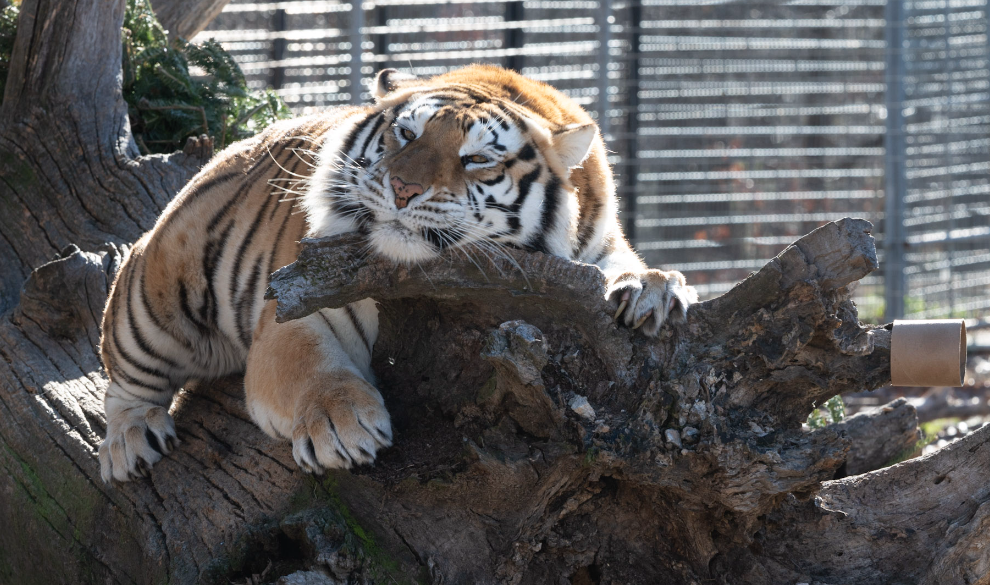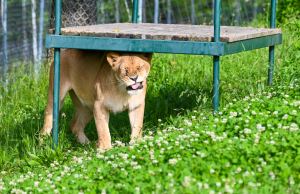
When giving tours here at Turpentine Creek Wildlife Refuge, we try to fit as much information into the 45-minute tram ride as we can. However, there are many things still left to discuss, and often times we receive a number of questions after that we are more than excited to answer! Perhaps you’ve even wondered about some of these questions yourself.
Do big cats hack up hairballs after grooming?
When cats groom themselves, they lick their fur. Their tongues have bristles on them called papillae. These bristles grab the loose fur and it is swallowed, however, fur is not digestible. The fur is either coughed up, vomited up, or pooped out. But is it the same in big cats as it is in house cats? Big cats have the same grooming practices as a house cat so you would think it would be the same, but a research associate at the University of Minnesota Lion Center has never known a lion to hack up a hairball, in captivity or not. When a cat, domestic or wild, is fed a proper high-quality diet and has a healthy gastrointestinal system, hacked up hairballs will not make an appearance.

Do the animals at TCWR get ‘the zoomies’ like house pets tend to?
Domestic animals get random bursts of energy that we call ‘the zoomies’, technically called FRAP (Frenetic Random Activity Periods). Wild animals get the zoomies too! Occasionally when visiting you can catch these bursts of energy in our animals here at TCWR where an animal will sprint around their habitat for fun.
Do big cats purr?
Nope! It’s actually one of the defining characteristics of a big cat. Big cats can roar, not purr. The rule of thumb is that cats that can purr are not able to roar, and cats that can roar are not able to purr.
What is the bite force of a tiger?
The bite force of a tiger is about 1,050 psi. Although tigers are the largest big cat, they do not have the strongest bite force. That award goes to the jaguar, whose bite force is around 1,500 psi!

Which big cat is the fastest?
You might think you already know this answer. Most people will say that cheetahs are the fastest big cat. Unfortunately, those people would be wrong. Jaguars and lions are the fastest of the big cats. They can run up to 50 mph. But wait, can’t cheetahs run up to 75 mph? It’s true that cheetahs are the fastest land animal, but they aren’t classified as big cats. Cheetahs are not part of the Panthera genus. They also purr and lack the ability to roar (if you remember the rule of thumb mentioned earlier).
Do the animals at TCWR know their names? How do you name them?
Most, if not all, of animals here do know their names, but that doesn’t mean they’ll all respond to it (we’ve got some very stubborn animals here). The majority of our animals come to us already with a name. This is why we have multiple Tiggers, Jasmines, and Lakotas! They get to keep that name unless it is offensive, in those cases we will give them a new one. If they didn’t have a name when arriving, naming rights usually go out to donors and sponsors.
If lions are social animals, why are they in a habitat by themselves?
Lions are the only social cat. They live in groups called prides. However, most of our lions are in habitats by themselves. This is because we never introduce big cats to each other unless they lived together at the facility they were rescued from. Big cats are very territorial, and introducing them to each other could cause dangerous fights that we want to avoid. Even though the lions are in their own habitats, they are still able to have social interaction through caroling, as well as occasionally running along their fence lines with their neighbors.

I’m sure there are hundreds more questions you could think of, so come visit is here at Turpentine Creek Wildlife Refuge and talk to a Wildlife Interpreter!
Sources:
- https://www.nationalgeographic.com/animals/article/animals-lions-cats-health-pets
- https://carnegiemnh.org/cat-chat-101-the-basics-of-domestic-and-wild-vocalizations/
- https://www.catster.com/lifestyle/what-cat-has-strongest-bite/
- https://pangovet.com/pet-breeds/cats/fastest-cats-in-the-world/
